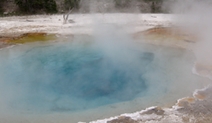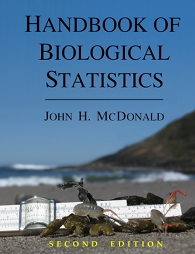Research Interests
The overall theme of the research in my lab is detecting the effects of natural selection on nuclear genes. This includes detecting the effects of balancing selection and directional selection on variation within populations, variation among populations, and variation among species, and it includes a mix of empirical and theoretical work.
Prospective Students
I am not seeking a graduate student or post doc for my lab at this time. I may have opportunities for undergraduates with a strong interest in evolutionary biology and a willingness to work independently. Undergrads interested in working in my lab should apply using the undergraduate research interest form.
I will be glad to advise UD undergrads and others with an interest in evolutionary biology who are planning to apply to graduate schools.
Current Projects
Statistical tests for adaptive evolution of proteins to different temperatures: When protein sequences from two species are compared, the neutral theory of molecular evolution predicts that the number of amino acid sites that differ in one direction should be equal to the number of sites that differ in the opposite direction. For example, the number of sites with serine in species A and alanine in species B should equal the number of sites with alanine in A and serine in B. Substitutional asymmetry, where one direction of difference is more common than the other, may indicate that natural selection favors one amino acid over the other in one of the species. I have compared protein sequences from high-temperature (thermophilic) prokaryotes and their cool-temperature (mesophilic) relatives and found a lot of evidence for asymmetrical patterns of substitution (McDonald 2010). I am currently seeing whether similar patterns of temperature-related substitutional asymmetry occur in eukaryotes.
Adaptation to global warming in enzyme allele frequencies: In the 1970s and 1980s, the technique of allozyme electrophoresis revealed patterns of allele frequency in several species that were associated with latitude. One example is the amphipod crustacean ("sand hopper") Megalorchestia californiana, which lives on sandy beaches on the Pacific coast of the United States. In 1983, I collected samples from Washington state to southern California, and I found that two enzymes had alleles that were common in the southern populations but became less common towards the north. Allele frequencies were strongly correlated with the average January temperatures near the sample locations. Since that time, the climate in that area has warmed by over one degree Celsius. I have sampled from the same locations and will see whether the southern-associated alleles have increased in frequency in the last 25 years in response to global warming.
Courses
BISC 413: Advanced Genetics Laboratory
BISC 495: Evolution
BISC 643: Biological Data Analysis
BISC 656: Evolutionary Genetics
Software
These software programs analyze DNA and protein sequences for evidence of natural selection. They and their Pascal source code are freely available, in both Macintosh and Windows versions. I don't know whether the programs work with the latest Mac and Windows operating systems; let me know if you have problems, and I'll recompile them.
DNA Slider: Tests heterogeneity in the polymorphism-to-divergence ratio among different regions of a gene, as a way of detecting selective sweeps or balancing selection (McDonald 1998).
SliderPrep: Prepares aligned DNA sequences for input into DNA Slider.
Asymmetry programs: AmbiguityRemover removes ambiguously aligned sites from protein sequence alignments, for input into AsymmetryCounter. AsymmetryCounter counts the number of amino acid subsitutions in each direction between pairs of protein sequences. AsymmetryScaler takes the results from AsymmetryCounter and summarizes substitutional asymmetry data in a single scale (McDonald 1999).
Resources
Handbook of Biological Statistics: A free, online textbook which I wrote for my Biological Data Analysis class, a one-semester, graduate-level survey of many of the statistical tests commonly used in analyzing biological data. The handbook includes instructions for performing the tests in SAS and also has downloadable spreadsheets to perform most of the tests. A print version of the handbook is available as a free pdf or a 304-page, spiral-bound book for $18.
Myths of Human Genetics: A review of the literature on human traits that biology teachers often use to demonstrate genetics, such as tongue rolling, attached earlobes, and mid-digital hair. Almost all of these traits do not have a simple genetic basis, and teachers should stop using them. A print version is available as a free pdf or a 74-page, spiral-bound book for $10.
Guide to searching for biological literature: A guide to using the Web of Science (Science Citation Index) to search for scientific literature, plus instructions and links to obtain scientific papers. While this is specifically aimed at Delaware students, much of the information will be useful at other institutions.
Public Outreach
I have given several public talks, have appeared on TV, and have been quoted in newspapers explaining the difference between the science of evolutionary biology and the pseudoscience of creationism, and I would be glad to have further opportunities to promote evolution. To poke fun at creationist Michael Behe's claim that a mousetrap is a good analogy for an "irreducibly complex" biochemical system, I have drawn mousetraps in several stages of reduced complexity.
Publications
Wenne, R., L. Bach, M. Zbawicka, J. Strand, and J.H. McDonald. 2015. A first report on coexistence and hybridization of Mytilus trossulus and M. edulis mussels in Greenland. Polar Biology, in press.
Bayha, K.M., M. H. Chang, C. L. Mariani, J. L. Richardson, D. L. Edwards, T. S. DeBoer, C. Moseley, E. Aksoy, M. B. Decker, P. M. Gaffney, G. R. Harbison, J. H. McDonald, and A. Caccone. 2015. Worldwide phylogeography of the invasive ctenophore Mnemiopsis leidyi (Ctenophora) based on nuclear and mitochondrial DNA data. Biological Invasions 17: 827-850.
McDonald, J.H. 2014. Handbook of Biological Statistics, 3rd ed. Baltimore: Sparky House Publishing.
Manthey, A.L., S.A. Lachke, P.G. FitzGerald, R.W. Mason, D.A. Scheiblin, J.H. McDonald, and M.K. Duncan. 2014. Loss of Sip1 leads to migration defects and retention of ectodermal markers during lens development. Mechanisms of Development 131: 86-110.
McDonald, J.H., and K.W. Dunn. 2013. Statistical tests for measures of colocalization in biological microscopy. Journal of Microscopy 252: 295-302.
McDonald, J.H. 2013. Geographic variation in Megalorchestia californiana allele frequencies may be caused by winter rather than summer temperatures. Marine Ecology Progress Series 488: 201-207.
Hoffman, G., W.W. Le, A. Entezam, N. Otsuka, Z.-B. Tong, L. Nelson, J. Flaws, S. Jafar, J.H. McDonald, and K. Usdin. 2012. Ovarian abnormalities in a mouse model of Fragile X primary ovarian insufficiency. J. Histochem. Cytochem. 60: 439-456.
McDonald, J.H. 2011. Myths of human genetics. Baltimore: Sparky House Publishing. [online], [print] or [pdf]
Dunn, K.W., M.M. Kamocka, and J.H. McDonald. 2011. A practical guide to evaluating colocalization in biological microscopy. Am. J. Physiol.--Cell Physiol. 300: C723-C742.[pdf]
McDonald, J.H. 2010. Temperature adaptation at homologous sites in proteins from nine thermophile-mesophile species pairs. Genome Biol. Evol. 2: 267-276. [pdf]
McDonald, J.H. 2009. Handbook of Biological Statistics, 2nd ed. Baltimore: Sparky House Publishing. [online], [print], or [pdf]
McDonald, J.H. 2008. Handbook of Biological Statistics. Baltimore: Sparky House Publishing.
McDonald, J.H. 2006. Apparent trends of gain and loss in protein evolution due to nearly neutral evolution. Mol. Biol. Evol. 23: 240-244. [pdf]
Bayha, K.M., G.R. Harbison, J.H. McDonald, and P.M. Gaffney. 2004. Preliminary investigation on the molecular systematics of the invasive ctenophore Beroe ovata. In: Dumon, H.J., T.A. Shiganova, and U. Niermann (eds.) Aquatic invasions of the Black, Caspian and Mediterranean Seas. Kluwer Academica Publishers, Dordrecht.
Riginos, C., and J.H. McDonald. 2003. Positive selection on an acrosomal sperm protein, M7 lysin, in three species of the mussel genus Mytilus. Mol. Biol. Evol. 20: 200-207. [pdf]
Verrelli, B.C., J.H. McDonald, G. Argyropoulos, G. Destrol-Bisol, A. Froment, A. Drousiotou, G. Lefranc, A.N. Helal, J. Loiselet, and S.A. Tishkoff. 2002. Evidence for balancing selection from nucleotide sequence analyses of human G6PD. Am. J. Hum. Genet. 71: 1112-1128. [pdf]
McDonald, J.H. 2001. Patterns of temperature adaptation in proteins from the bacteria Deinococcus radiodurans and Thermus thermophilus. Mol. Biol. Evol. 18: 741-749. [pdf]
McDonald, J.H., A.M. Grasso and L.K. Rejto. 1999. Patterns of temperature adaptation in proteins from Methanococcus and Bacillus. Mol. Biol. Evol. 16: 1785-1790. [pdf]
Edgcomb, V.P., J.H. McDonald, R. Devereux, and D.W. Smith. 1999. Estimation of bacterial cell numbers in humic acid-rich salt marsh sediments with probes directed to 16s ribosomal DNA. Appl. Envt. Micro. 65: 1516 -1523. [pdf]
McDonald, J.H. 1998. Improved tests for heterogeneity across a region of DNA sequence in the ratio of polymorphism to divergence. Mol. Biol. Evol. 15: 377-384. [pdf]
Bradley, R.D., R.M. Adkins, R.L. Honeycutt, and J.H. McDonald. 1998. Nucleotide polymorphism at the alcohol dehydrogenase locus of pocket gophers, genus Geomys. Mol. Biol. Evol. 15: 709-717. [pdf]
Miller, C., J. McDonald and D. Francis. 1996. Evolution of promoter sequences: elements of a canonical promoter for prespore genes of Dictyostelium. J. Mol. Evol. 43: 185-193. [pdf]
McDonald, J.H., B.C. Verrelli and L.B. Geyer. 1996. Lack of geographic variation in anonymous nuclear polymorphisms in the American oyster, Crassostrea virginica. Mol. Biol. Evol. 13: 1114-1118. [pdf]
McDonald, J.H. 1996. Detecting non-neutral heterogeneity across a region of DNA sequence in the ratio of polymorphism to divergence. Mol. Biol. Evol. 13: 253-260. [pdf]
McDonald, J.H. 1994. Detecting natural selection by comparing geographic variation in protein and DNA polymorphisms. pp. 88-100 in Non- neutral evolution: theories and molecular data, B. Golding, ed. New York: Chapman and Hall.
McDonald, J.H. and M. Kreitman. 1991. Scientific correspondence. Nature 354: 116. [pdf]
McDonald, J.H. and M. Kreitman. 1991. Adaptive protein evolution at the Adh locus in Drosophila. Nature 351: 652-654. [pdf]
McDonald, J.H. 1991. Contrasting amounts of geographic variation as evidence for direct selection: the Mpi and Pgm loci in eight crustacean species. Heredity 67:215-219. [pdf]
McDonald, J.H., R. Seed and R.K. Koehn. 1991. Allozymes and morphometric characters of three species of Mytilus in the Northern and Southern Hemispheres. Mar. Biol. 111:323-333. [pdf]
McDonald, J.H., R.K. Koehn, E.S. Balakirev, G.P. Manchenko, A.I. Pudovkin, S.O. Sergiyevsky and K.V. Krutovsky. 1990. On species identity of "the common mussel" inhabiting Asiatic coasts of the Pacific Ocean. Biologiya Morya 1990(1): 13-22. [in Russian]
McDonald, J.H. and J.F. Siebenaller. 1989. Similar geographic variation at the Lap locus in the mussels Mytilus trossulus and M. edulis. Evolution 43: 228-231. [pdf]
McDonald, J.H. 1989. Selection component analysis of the Mpi locus in the amphipod Platorchestia platensis. Heredity 62: 243-249. [pdf]
McDonald, J.H. and R.K. Koehn. 1988. The mussels Mytilus galloprovincialis and M. trossulus on the Pacific coast of North America. Mar. Biol. 99: 111-118. [pdf]
McDonald, J.H. 1987. Repeated geographic variation at three enzyme loci in the amphipod Platorchestia platensis. Evolution 41: 438-441. [pdf]
Rodhouse, P.G., J.H. McDonald, R.I.E. Newell and R.K. Koehn. 1986. Gamete production, somatic growth and multiple-locus enzyme heterozygosity in Mytilus edulis. Mar. Biol. 90: 209-214.
McDonald, J.H. 1985. Size-related and geographic variation at two enzyme loci in Megalorchestia californiana (Amphipoda: Talitridae). Heredity 54: 359-366. [pdf]
Diehl, W.J., P.M. Gaffney, J.H. McDonald and R.K. Koehn. 1985. Relationship between weight-standardized oxygen consumption and multiple-locus heterozygosity in the mussel, Mytilus edulis. Proceedings of the 19th European Marine Biology Symposium, pp. 529-534.
This page was last revised August 22, 2015.
Its URL is
http://udel.edu/~mcdonald/index.html


